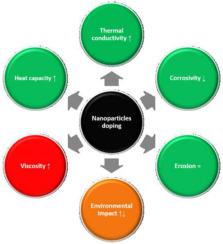当前位置:
X-MOL 学术
›
Sol. Energy Mater. Sol. Cells
›
论文详情
Our official English website, www.x-mol.net, welcomes your
feedback! (Note: you will need to create a separate account there.)
Nanofluids based on molten carbonate salts for high-temperature thermal energy storage: Thermophysical properties, stability, compatibility and life cycle analysis
Solar Energy Materials and Solar Cells ( IF 6.3 ) Pub Date : 2021-01-01 , DOI: 10.1016/j.solmat.2020.110838 Yaroslav Grosu , Argyrios Anagnostopoulos , Boris Balakin , Janusz Krupanek , María Elena Navarro , Luis González-Fernández , Yulong Ding , Abdessamad Faik
Solar Energy Materials and Solar Cells ( IF 6.3 ) Pub Date : 2021-01-01 , DOI: 10.1016/j.solmat.2020.110838 Yaroslav Grosu , Argyrios Anagnostopoulos , Boris Balakin , Janusz Krupanek , María Elena Navarro , Luis González-Fernández , Yulong Ding , Abdessamad Faik

|
Abstract Molten salts-based nanofluids have been widely considered for Thermal Energy Storage (TES) applications due to their enhanced thermophysical properties. However, the application of such fluids faces many challenges, among which are the correct determination of their properties, stability, compatibility with construction materials and the overall environmental impact. In this work, we attempt to provide a comprehensive analysis of nanofluids based on nano-alumina and molten carbonate salt for the benefit of next-generation high-temperature TES applications. In particular, considerable statistics, cross-verification, novel preparation and characterization methods were applied to record ~12% increase of thermal conductivity, ~7% increase of heat capacity and ~35% increase of viscosity. It was demonstrated that such nanofluids have poor dispersion stability under static conditions; however, the enhanced thermophysical properties can be maintained by mechanical stimuli, e.g. mixing or redistribution. We show that some nanoparticles interact with typical construction materials such as stainless steel 310 by forming mixed oxides and considerably reducing the corrosion rates. An erosion study has been performed demonstrating negligible effect of nanoparticles even in the case of their strong agglomeration. Finally, life cycle analysis revealed that viscosity and preparation method of such nanofluids must be targeted to minimize the environmental impact.
中文翻译:

用于高温热能储存的基于熔融碳酸盐的纳米流体:热物理性质、稳定性、相容性和生命周期分析
摘要 基于熔盐的纳米流体因其增强的热物理特性而被广泛考虑用于热能储存 (TES) 应用。然而,此类流体的应用面临许多挑战,其中包括正确确定其性质、稳定性、与建筑材料的相容性以及整体环境影响。在这项工作中,我们试图对基于纳米氧化铝和熔融碳酸盐的纳米流体进行全面分析,以利于下一代高温 TES 应用。特别是,大量的统计数据、交叉验证、新的制备和表征方法被用于记录热导率增加约 12%、热容增加约 7% 和粘度增加约 35%。结果表明,这种纳米流体在静态条件下的分散稳定性较差;然而,增强的热物理特性可以通过机械刺激保持,例如混合或重新分布。我们展示了一些纳米粒子通过形成混合氧化物并显着降低腐蚀速率与典型的建筑材料(如不锈钢 310)相互作用。已经进行的侵蚀研究表明,即使在纳米颗粒强烈团聚的情况下,纳米颗粒的影响也可以忽略不计。最后,生命周期分析表明,此类纳米流体的粘度和制备方法必须有针对性,以尽量减少对环境的影响。我们展示了一些纳米粒子通过形成混合氧化物并显着降低腐蚀速率与典型的建筑材料(如不锈钢 310)相互作用。已经进行的侵蚀研究表明,即使在纳米颗粒强烈团聚的情况下,纳米颗粒的影响也可以忽略不计。最后,生命周期分析表明,此类纳米流体的粘度和制备方法必须有针对性,以尽量减少对环境的影响。我们展示了一些纳米粒子通过形成混合氧化物并显着降低腐蚀速率与典型的建筑材料(如不锈钢 310)相互作用。已经进行的侵蚀研究表明,即使在纳米颗粒强烈团聚的情况下,纳米颗粒的影响也可以忽略不计。最后,生命周期分析表明,此类纳米流体的粘度和制备方法必须有针对性,以尽量减少对环境的影响。
更新日期:2021-01-01
中文翻译:

用于高温热能储存的基于熔融碳酸盐的纳米流体:热物理性质、稳定性、相容性和生命周期分析
摘要 基于熔盐的纳米流体因其增强的热物理特性而被广泛考虑用于热能储存 (TES) 应用。然而,此类流体的应用面临许多挑战,其中包括正确确定其性质、稳定性、与建筑材料的相容性以及整体环境影响。在这项工作中,我们试图对基于纳米氧化铝和熔融碳酸盐的纳米流体进行全面分析,以利于下一代高温 TES 应用。特别是,大量的统计数据、交叉验证、新的制备和表征方法被用于记录热导率增加约 12%、热容增加约 7% 和粘度增加约 35%。结果表明,这种纳米流体在静态条件下的分散稳定性较差;然而,增强的热物理特性可以通过机械刺激保持,例如混合或重新分布。我们展示了一些纳米粒子通过形成混合氧化物并显着降低腐蚀速率与典型的建筑材料(如不锈钢 310)相互作用。已经进行的侵蚀研究表明,即使在纳米颗粒强烈团聚的情况下,纳米颗粒的影响也可以忽略不计。最后,生命周期分析表明,此类纳米流体的粘度和制备方法必须有针对性,以尽量减少对环境的影响。我们展示了一些纳米粒子通过形成混合氧化物并显着降低腐蚀速率与典型的建筑材料(如不锈钢 310)相互作用。已经进行的侵蚀研究表明,即使在纳米颗粒强烈团聚的情况下,纳米颗粒的影响也可以忽略不计。最后,生命周期分析表明,此类纳米流体的粘度和制备方法必须有针对性,以尽量减少对环境的影响。我们展示了一些纳米粒子通过形成混合氧化物并显着降低腐蚀速率与典型的建筑材料(如不锈钢 310)相互作用。已经进行的侵蚀研究表明,即使在纳米颗粒强烈团聚的情况下,纳米颗粒的影响也可以忽略不计。最后,生命周期分析表明,此类纳米流体的粘度和制备方法必须有针对性,以尽量减少对环境的影响。











































 京公网安备 11010802027423号
京公网安备 11010802027423号